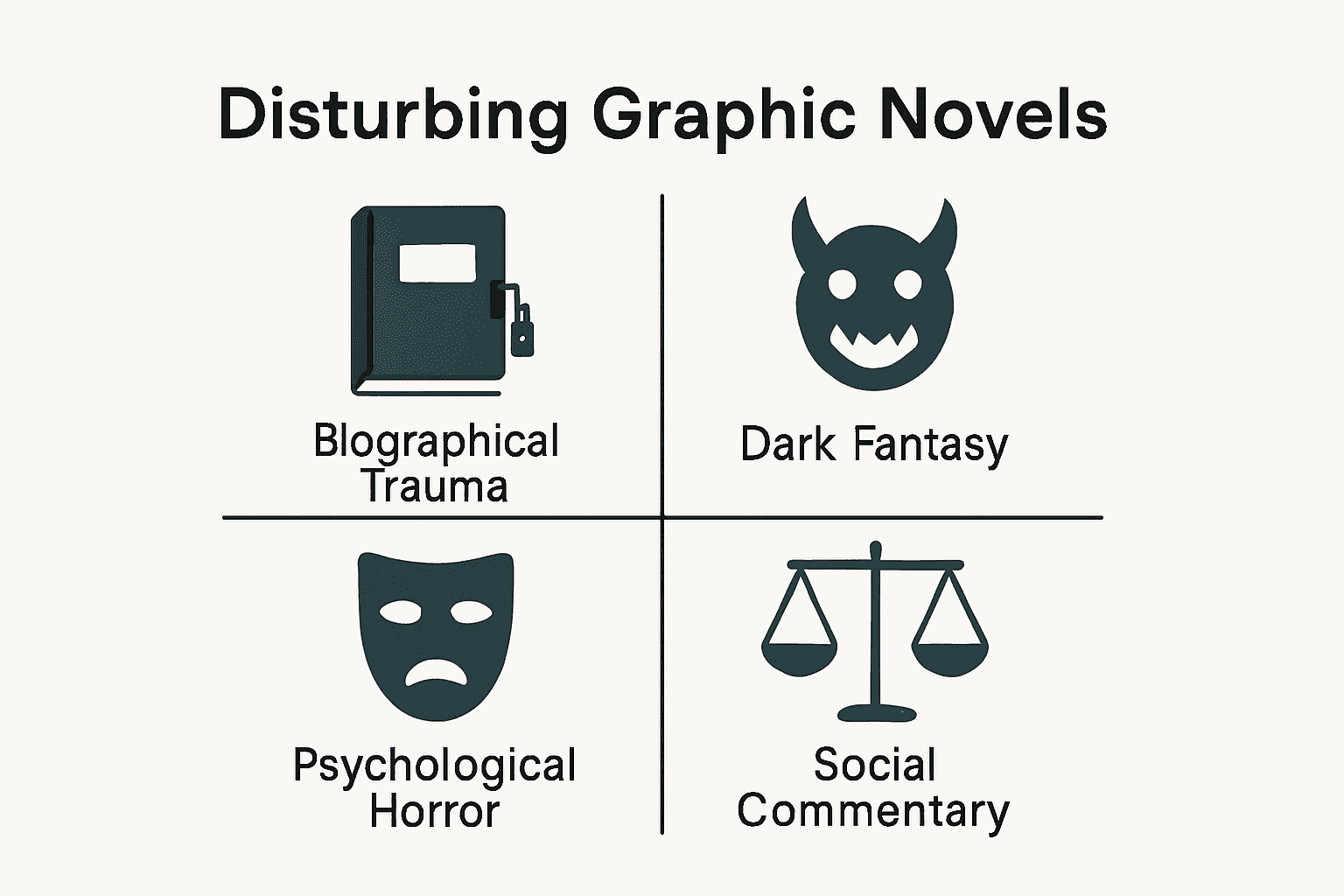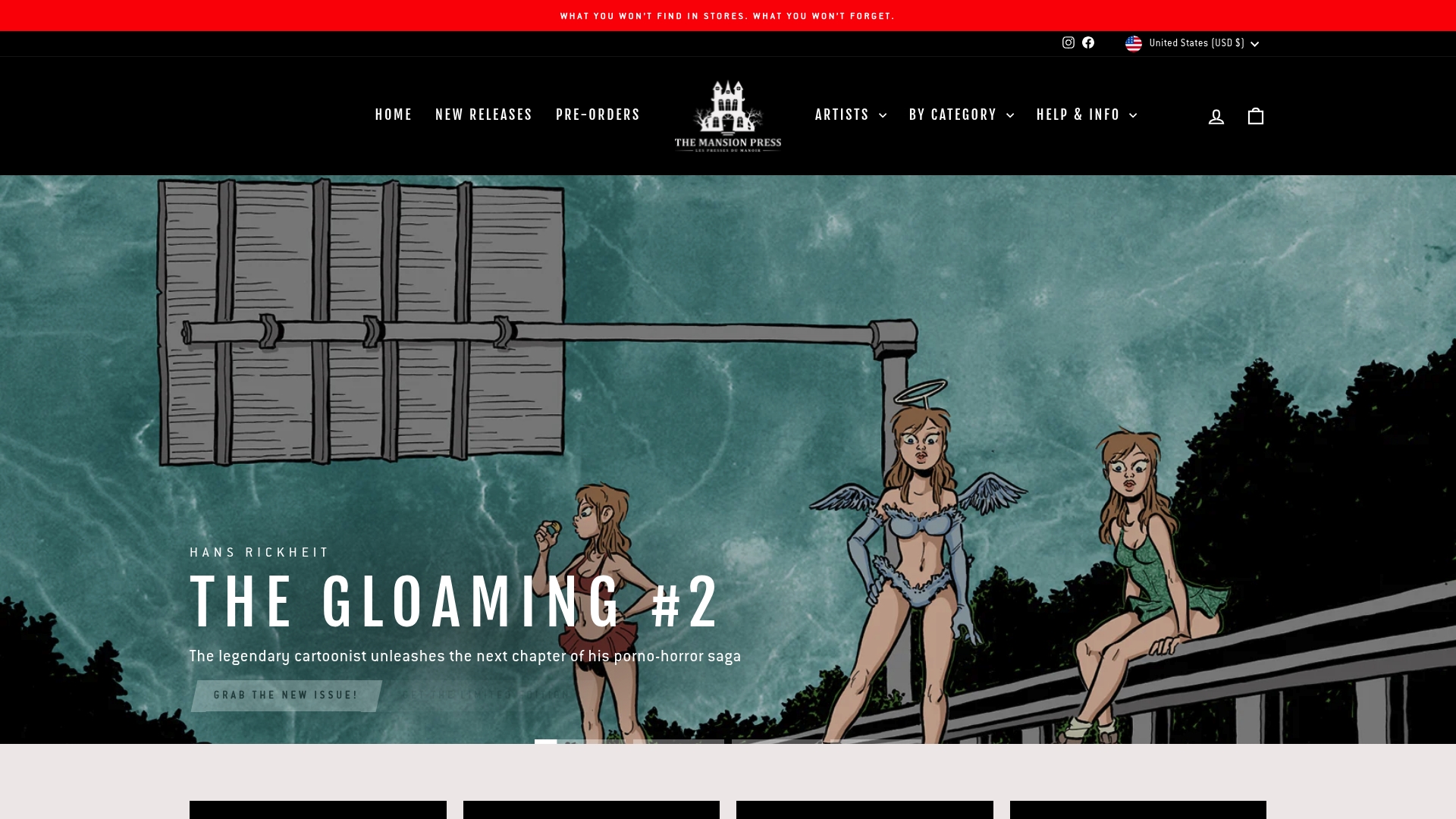Disturbing Graphic Novels Explained: Complete Guide
Most comic book fans never expect that a story could leave them genuinely unsettled. Disturbing graphic novels walk this thin line, using intense visuals and raw themes to spark powerful reactions. These bold works go far beyond typical entertainment, diving straight into issues like trauma, morality, and the darker sides of society. Whether you are curious, cautious, or simply compelled, learning about what defines these novels will open your eyes to an art form that is as thought-provoking as it is controversial.
Table of Contents
- Defining Disturbing Graphic Novels And Core Themes
- Major Types And Influential Works
- Visual Styles And Narrative Techniques
- Psychological Impact And Reader Experience
- Ethical Concerns And Age Restrictions
- Collecting, Curating, And Legal Implications
Key Takeaways
| Point | Details |
|---|---|
| Disturbing graphic novels as a subgenre | They challenge traditional narratives through complex themes of psychological trauma and social dysfunction, forcing readers to confront uncomfortable truths. |
| Core themes and techniques | These works often employ unique visual storytelling techniques that enhance emotional engagement, including fragmented narratives and surreal visuals. |
| Psychological impact on readers | They provoke deep emotional responses and encourage reflection on trauma and moral ambiguity, transforming readers’ engagement with the narratives. |
| Ethical considerations | The genre raises important questions about content sensitivity and age appropriateness, necessitating responsible representation in storytelling. |
Defining Disturbing Graphic Novels and Core Themes
Disturbing graphic novels represent a provocative subgenre of visual storytelling that challenges traditional narrative boundaries by exploring complex, often uncomfortable psychological and societal themes. Unlike conventional comic books, these works intentionally push readers beyond their comfort zones, using powerful visual imagery and narrative techniques to confront challenging emotional and intellectual landscapes.
According to research from CORE Academic, graphic novels serve as unique mediums for exploring profound human experiences, with disturbing works specifically designed to provoke emotional and intellectual responses. These novels often tackle subjects like trauma, social dysfunction, psychological breakdown, and existential crisis through intricate visual metaphors and raw storytelling approaches.
The core themes in disturbing graphic novels typically center around several key psychological and social dimensions:
- Psychological Trauma: Exploring deep emotional wounds and their lasting psychological impacts
- Social Dysfunction: Examining broken systems, societal failures, and human marginalization
- Existential Questioning: Challenging readers’ fundamental understanding of human nature
- Moral Ambiguity: Presenting complex scenarios without clear ethical resolutions
Research from UNCG Library highlights that the visual nature of graphic novels allows creators to communicate intense emotional experiences more viscerally than traditional text-based narratives. By combining compelling artwork with nuanced storytelling, these novels create immersive experiences that force readers to confront uncomfortable truths about human psychology and social dynamics.
When exploring understanding cult graphic novels, readers will discover that disturbing graphic novels are not merely shock value entertainment, but profound artistic statements that challenge societal norms and individual perceptions. They represent a sophisticated form of social commentary, using visual storytelling to dissect complex human experiences in ways traditional literature cannot.
Major Types and Influential Works
Disturbing graphic novels encompass diverse genres and styles, each pushing narrative boundaries through unique storytelling approaches. These works can be categorized into distinct types that challenge readers’ perceptions and explore profound psychological landscapes.
Biographical Trauma Narratives represent one of the most powerful subcategories. Wikipedia’s entry on Maus highlights how Art Spiegelman’s groundbreaking work exemplifies this type, using anthropomorphic characters to portray the Holocaust’s devastating human impact. By transforming historical trauma into a visually compelling narrative, such works create immersive experiences that transcend traditional storytelling methods.
Key Types of Disturbing Graphic Novels:
- Biographical Trauma Narratives: Personal stories exploring historical suffering
- Dark Fantasy Explorations: Psychological journeys through mythical landscapes
- Psychological Horror: Investigating human mental breakdown and existential dread
- Social Commentary Narratives: Critiquing systemic oppression and societal dysfunction
Wikipedia’s analysis of Berserk demonstrates another critical type: Dark Fantasy Graphic Novels. This genre uses intense visual storytelling to explore complex themes of fate, human suffering, and moral ambiguity. Berserk specifically illustrates how graphic novels can transform violent imagery into profound philosophical investigations, pushing readers to confront uncomfortable truths about human nature.
These works are not merely entertainment but sophisticated artistic statements.
 When exploring dark graphic novels, readers discover narratives that challenge conventional storytelling, using visual metaphors and raw emotional landscapes to communicate experiences beyond traditional literary forms.
When exploring dark graphic novels, readers discover narratives that challenge conventional storytelling, using visual metaphors and raw emotional landscapes to communicate experiences beyond traditional literary forms.
Visual Styles and Narrative Techniques
Disturbing graphic novels leverage complex visual storytelling techniques that transform traditional narrative structures, using innovative approaches to communicate profound psychological experiences. These works go beyond simple illustration, employing sophisticated visual languages that challenge readers’ perceptual and emotional boundaries.
Research from arXiv reveals intricate details about how visual elements like speech balloons contribute to narrative complexity. By strategically manipulating visual components such as panel layout, character positioning, and graphical annotations, creators can communicate multilayered emotional landscapes that transcend traditional textual storytelling.
Key Visual Narrative Techniques in Disturbing Graphic Novels:
- Fragmented Panel Sequences: Disrupting linear narrative flow
- Surreal Color Palettes: Representing psychological states
- Distorted Character Perspectives: Visualizing mental instability
- Overlapping Visual Metaphors: Creating multi-dimensional emotional landscapes
arXiv’s research on character networks demonstrates how character interactions and visual representations fundamentally reshape narrative structures. By exploring understanding visual narrative, graphic novelists create immersive experiences that blur boundaries between reality, perception, and psychological experience.
These visual techniques are not mere stylistic choices but sophisticated communication strategies. They transform graphic novels from simple illustrated stories into profound psychological explorations, challenging readers to engage with complex emotional and intellectual terrains through innovative visual languages.
Psychological Impact and Reader Experience
Disturbing graphic novels create profound psychological journeys that challenge readers’ emotional boundaries, transforming passive consumption into active psychological engagement. These works are not merely visual narratives but complex emotional experiences that probe the deepest recesses of human psychological complexity.
UNCG Library research reveals how visual storytelling techniques dramatically enhance reader comprehension and emotional resonance. By leveraging intricate visual mechanisms, graphic novels create immersive experiences that engage readers on multiple psychological levels, transcending traditional narrative limitations.
Key Psychological Impact Dimensions:
- Emotional Trigger Mechanisms: Deliberately provoking visceral responses
- Cognitive Dissonance: Challenging readers’ preconceived psychological frameworks
- Traumatic Empathy: Creating deep emotional connections through visual storytelling
- Psychological Projection: Enabling readers to explore complex inner landscapes
Considering works like Wikipedia’s analysis of My Friend Dahmer, these graphic novels serve as powerful psychological explorations that deconstruct human complexity. By examining understanding psychological horror comics, readers can appreciate how these narratives function as sophisticated psychological investigations.
Ultimately, disturbing graphic novels are not about shock value but profound psychological exploration. They invite readers into uncomfortable yet transformative spaces, challenging individual perceptions and expanding emotional intelligence through carefully crafted visual narratives.
Ethical Concerns and Age Restrictions
Disturbing graphic novels occupy a complex ethical landscape, challenging traditional boundaries of artistic expression and audience sensitivity. These works demand careful consideration of content appropriateness, psychological impact, and the potential for profound emotional and intellectual engagement across different age groups.
Wikipedia’s entry on Maus illustrates the complex ethical debates surrounding graphic novels, particularly those addressing traumatic historical experiences. The work’s graphic depiction of Holocaust experiences has sparked significant discussions about content restrictions, demonstrating how disturbing graphic novels challenge conventional narrative and representational boundaries.
Key Ethical Considerations in Disturbing Graphic Novels:
- Content Sensitivity: Balancing artistic integrity with potential psychological harm
- Age-Appropriate Filtering: Developing nuanced content rating systems
- Trauma Representation: Responsibly depicting difficult historical and personal experiences
- Intellectual Freedom: Protecting artistic expression while maintaining ethical standards
Wikipedia’s analysis of Muzan-e highlights historical precedents of explicit visual storytelling, revealing that concerns about graphic content are not new. By exploring understanding creepy comic book imagery, readers can appreciate the delicate balance between artistic expression and responsible representation.
Ethical engagement with disturbing graphic novels requires a sophisticated approach.
 These works are not designed for gratuitous shock, but to provoke meaningful reflection, challenge societal assumptions, and create spaces for complex emotional and intellectual dialogue across diverse audiences.
These works are not designed for gratuitous shock, but to provoke meaningful reflection, challenge societal assumptions, and create spaces for complex emotional and intellectual dialogue across diverse audiences.
Collecting, Curating, and Legal Implications
Collecting disturbing graphic novels requires a sophisticated approach that balances artistic appreciation, legal considerations, and ethical responsibility. Collectors must navigate complex terrain that involves understanding not just the aesthetic value of these works, but their broader cultural and legal contexts.
Wikipedia’s analysis of Habibi illustrates the intricate challenges of collecting graphic novels that address sensitive cultural themes. These works demand nuanced understanding, as they often navigate complex representations of religion, identity, and societal tensions that extend beyond simple artistic categorization.
Key Considerations for Graphic Novel Collectors:
- Provenance Verification: Ensuring authenticity and legal acquisition
- Cultural Sensitivity: Understanding contextual and historical representations
- Preservation Techniques: Maintaining physical and archival integrity
- Legal Compliance: Navigating potential censorship and copyright issues
Wikipedia’s examination of Skin further demonstrates the legal complexities surrounding controversial graphic novels. By consulting the collector’s guide for graphic novels, enthusiasts can develop sophisticated strategies for building responsible and meaningful collections.
Ultimately, collecting disturbing graphic novels is an intellectual pursuit that requires more than financial investment. It demands deep engagement, critical thinking, and a commitment to understanding the complex narratives that challenge and expand our collective understanding of human experience.
Dive Deep Into Disturbing Graphic Novels With Exclusive Collector’s Editions
The article outlines how disturbing graphic novels push boundaries with psychological trauma, social dysfunction, and moral ambiguity. If these complex themes resonate with you, finding unique editions that visually and narratively capture these intense experiences can be challenging. Many readers seek graphic novels that not only tell difficult stories but showcase innovative visual storytelling and emotional depth—exactly what discerning art enthusiasts and collectors crave.

Explore rare and limited-edition graphic novels at The Mansion Press, your premier destination for artbooks and collectibles that bring these powerful narratives to life. Whether you are passionate about biographical trauma narratives or psychological horror, our carefully curated selection connects you directly with creators who redefine graphic storytelling. Start your collection today to experience these profound works firsthand and gain access to upcoming releases through easy pre-orders. Visit The Mansion Press now and transform your appreciation of disturbing graphic novels into a tangible, stunning collection.
Frequently Asked Questions
What are disturbing graphic novels?
Disturbing graphic novels are a subgenre of visual storytelling that explore complex psychological and societal themes, often pushing readers beyond their comfort zones with raw imagery and thought-provoking narratives.
What themes are commonly found in disturbing graphic novels?
Key themes include psychological trauma, social dysfunction, existential questioning, and moral ambiguity, allowing for deep exploration of human experiences and societal issues.
How do visual elements enhance storytelling in disturbing graphic novels?
Visual elements such as fragmented panel sequences, surreal color palettes, and overlapping visual metaphors create immersive experiences that communicate complex emotional landscapes, enriching the reader’s understanding of the narrative.
Why are ethical considerations important in disturbing graphic novels?
Ethical considerations are significant to balance artistic expression with content sensitivity, ensuring responsible portrayal of traumatic experiences and protecting audiences from potential psychological harm.
Recommended
- 7 Disturbing Comics List: Must-Reads for Fans – The Mansion Press
- Graphic Novel Genres Explained: Complete Essential Guide – The Mansion Press
- How Graphic Novels Influence Culture: Complete Guide – The Mansion Press
- Understanding Graphic Novel Formats: A Comprehensive Guide – The Mansion Press
- Short Reads vs Full Novels: Complete Guide - TheShortReads.com

